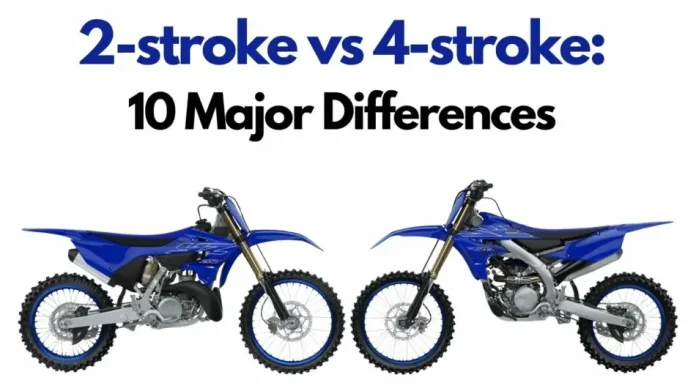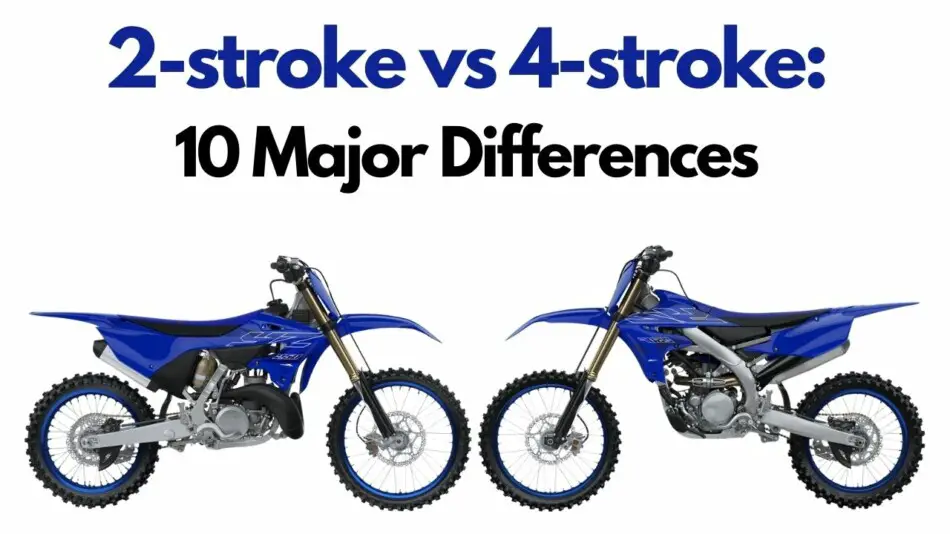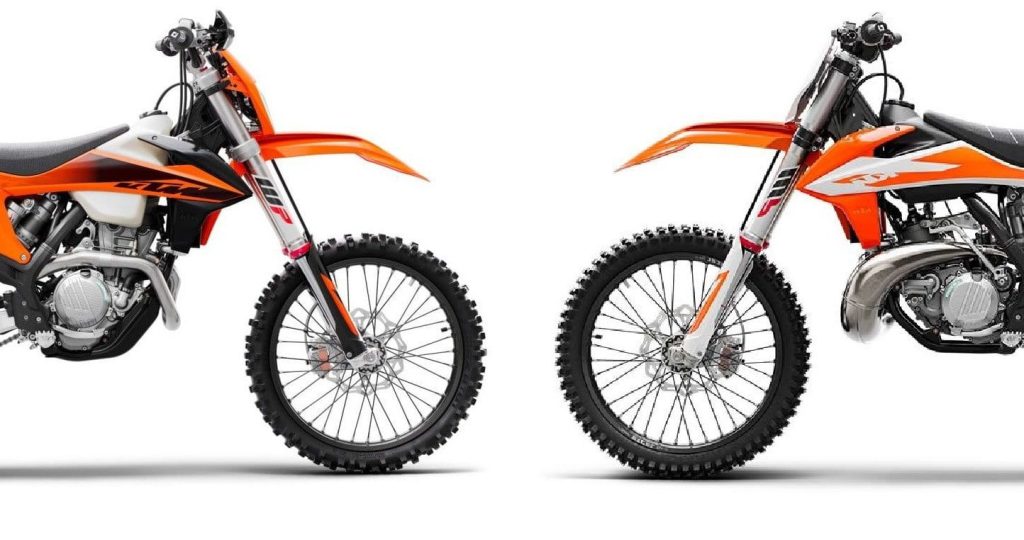When it comes to choosing between a 2-stroke or 4-stroke engine, the cost factor becomes a significant consideration. We’ve all wondered which option would save us some extra bucks in the long run. In this article, we’ll explore the financial aspect of the debate between these two engine types. By the end, you’ll have a clearer understanding of whether it’s the zippy 2-stroke or the reliable 4-stroke that comes out as the more pocket-friendly choice. Let’s dive in and find out!
This image is property of riskracing.com.
Cost of Purchase
Initial Cost
The initial cost of purchasing a 2-stroke or 4-stroke vehicle or equipment can vary depending on several factors. Generally, 2-stroke engines tend to be cheaper than their 4-stroke counterparts. This is primarily due to the simpler design and construction of 2-stroke engines, which require fewer parts. As a result, manufacturers can produce 2-stroke vehicles and equipment at a lower cost, making them more affordable for consumers. However, it is important to consider that the initial cost can also be influenced by other factors, such as the brand, model, and features of the vehicle or equipment.
Variety in Price Range
When it comes to the variety in price range, both 2-stroke and 4-stroke vehicles and equipment offer a wide range of options to suit different budgets. While 2-stroke engines are generally cheaper, there are still variations in price within the 2-stroke category based on factors such as brand, size, and extra features. On the other hand, 4-stroke engines tend to have a broader price range due to their more complex design and the availability of higher-end models with advanced features. This allows consumers to choose a vehicle or equipment that fits their specific budget and requirements.
Operating Costs
Fuel Efficiency
Fuel efficiency is a significant factor to consider when evaluating the operating costs of 2-stroke and 4-stroke engines. In general, 4-stroke engines are known for their superior fuel efficiency compared to 2-stroke engines. The combustion process in a 4-stroke engine is more efficient, requiring less fuel to generate the same amount of power. This translates to reduced fuel consumption and lower fuel costs over time. On the other hand, 2-stroke engines tend to consume more fuel due to their less efficient combustion process. As a result, operating a 2-stroke engine may lead to higher fuel expenses in the long run.
Oil Consumption
Another operating cost to consider is oil consumption. In 2-stroke engines, oil is mixed with the fuel and burned as part of the combustion process. This means that 2-stroke engines require regular oil refills to maintain proper lubrication and prevent engine damage. On the other hand, 4-stroke engines have a separate oil reservoir and do not require oil to be mixed with the fuel. This results in lower oil consumption and the need for oil refills less frequently, reducing the overall operating costs of 4-stroke engines.
Maintenance and Repairs
When it comes to maintenance and repairs, both 2-stroke and 4-stroke engines require regular servicing to ensure optimal performance and longevity. However, the overall cost of maintenance and repairs can vary between the two. 2-stroke engines are generally considered to be simpler and have fewer parts, making them easier and potentially less expensive to maintain and repair. On the other hand, 4-stroke engines have more components, which may require more frequent servicing and potentially higher costs for replacement parts. It is essential to consider the long-term maintenance and repair expenses when deciding between a 2-stroke and 4-stroke engine.
Emissions and Environmental Impact
Air Pollution and Greenhouse Gas Emissions
One of the significant concerns when evaluating the environmental impact of engines is their emissions. In this aspect, 4-stroke engines outperform 2-stroke engines. 4-stroke engines have a more efficient combustion process, resulting in lower emissions of pollutants such as carbon monoxide, hydrocarbons, and nitrogen oxides. Additionally, 4-stroke engines produce fewer greenhouse gas emissions, contributing less to climate change. On the other hand, 2-stroke engines release a higher amount of pollutants and greenhouse gases due to their less efficient combustion process. It is crucial to consider the environmental implications when choosing between the two engine types.
Noise Pollution
Noise pollution is another aspect to consider, especially in environments where noise restrictions are in place or where noise levels need to be minimized. In general, 4-stroke engines are quieter compared to 2-stroke engines. This is primarily due to the design and operation of the engines. 4-stroke engines have a more balanced and controlled combustion process, resulting in reduced engine noise. On the other hand, 2-stroke engines tend to be louder due to the rapid and less controlled combustion process. If noise pollution is a significant concern, opting for a 4-stroke engine might be more appropriate.
Lifespan and Durability
Longevity
When it comes to the lifespan and durability of engines, both 2-stroke and 4-stroke engines can have varying levels of longevity. Generally, 4-stroke engines are known for their longevity and durability. The design of 4-stroke engines allows for a more controlled combustion process, reducing stress on the engine components and resulting in less wear and tear. Additionally, 4-stroke engines tend to operate at lower speeds, further contributing to their durability. On the other hand, 2-stroke engines may have a shorter lifespan due to their design characteristics and higher operating speeds. However, with proper maintenance and care, both engine types can have a significant lifespan.
Wear and Tear
The wear and tear experienced by engines can impact their overall lifespan and durability. In this regard, 2-stroke engines are generally more prone to wear and tear compared to 4-stroke engines. The rapid and less controlled combustion process in 2-stroke engines can put more stress on the engine components, potentially leading to increased wear over time. On the other hand, 4-stroke engines have a more balanced and controlled combustion process, resulting in reduced wear and tear on the engine components. Regular maintenance and timely repairs can help mitigate wear and tear in both engine types.
Reliability
Reliability is a crucial factor to consider when evaluating the lifespan and durability of engines. Both 2-stroke and 4-stroke engines can be reliable if properly maintained and serviced. However, 4-stroke engines are generally considered to be more reliable due to their design characteristics. The more controlled combustion process, lower operating speeds, and reduced stress on the engine components contribute to the overall reliability of 4-stroke engines. On the other hand, 2-stroke engines may require more frequent maintenance and repairs to maintain their reliability, especially under intensive use or harsh operating conditions.
This image is property of www.adventurebiketroop.com.
Performance and Power
Acceleration and Speed
The performance and power capabilities of engines play a significant role, especially in applications where speed and acceleration are important factors. 2-stroke engines are generally known for their higher power-to-weight ratio and quicker acceleration compared to 4-stroke engines. The rapid combustion process and fewer moving parts in 2-stroke engines contribute to their ability to generate higher power output. Consequently, vehicles or equipment equipped with 2-stroke engines can often achieve higher speeds and faster acceleration. However, it is important to note that the specific power and performance characteristics can vary depending on the engine size and design.
Torque and Power
In terms of torque and power delivery, 4-stroke engines tend to offer more consistent and reliable performance compared to 2-stroke engines. The design of 4-stroke engines allows for a more controlled combustion process, resulting in a smoother and more gradual power delivery. This is particularly advantageous in applications that require a constant and reliable power output, such as heavy-duty equipment or vehicles carrying heavy loads. On the other hand, 2-stroke engines may provide higher peak power output, but their power delivery can be more abrupt and less consistent, which may not be suitable for certain applications.
Smoothness
The smoothness of engine operation can greatly impact the overall user experience and comfort. In this aspect, 4-stroke engines are generally known for their smoother operation compared to 2-stroke engines. The balanced and controlled combustion process in 4-stroke engines results in fewer vibrations and less overall engine noise. This contributes to a smoother and more refined experience for the user, reducing fatigue and enhancing comfort, especially during prolonged use. On the other hand, 2-stroke engines, with their rapid and less controlled combustion process, tend to produce more vibrations and noise, which may lead to a less smooth and comfortable user experience.
Application and Usage
Type of Vehicle or Equipment
The type of vehicle or equipment for which the engine is intended plays a crucial role in choosing between a 2-stroke and 4-stroke engine. While both engine types can be used in various applications, certain factors need to be considered. 2-stroke engines are often preferred in applications that prioritize power-to-weight ratio, such as motorcycles, personal watercraft, or handheld power tools. The higher power output and quicker acceleration of 2-stroke engines make them suitable for these applications. On the other hand, 4-stroke engines are generally preferred in applications that require constant and reliable power delivery, such as cars, trucks, or heavy-duty equipment. The more controlled combustion process and smoother power delivery of 4-stroke engines make them a better choice for these applications.
Frequency and Intensity of Use
The frequency and intensity of engine use should also be taken into consideration. If the engine will be used infrequently or for short durations, a 2-stroke engine may be more suitable. 2-stroke engines are known for their simplicity and ease of use, requiring less maintenance and servicing. They tend to start more easily, making them convenient for occasional use. However, if the engine will be used frequently or for extended periods, a 4-stroke engine may be more appropriate. The superior fuel efficiency, lower emissions, and overall durability of 4-stroke engines make them ideal for continuous and intensive use, reducing the overall operating costs in the long run.
This image is property of firstcheckpoint.com.
Availability and Accessibility
Availability of Parts and Services
When considering the availability and accessibility of parts and services, both 2-stroke and 4-stroke engines have their advantages and challenges. The availability of parts and services often depends on the popularity and demand for a particular engine type in a specific region. 2-stroke engines have been widely used for many years, which has resulted in a large market for parts and services. This can make it easier to find replacement parts and skilled technicians for repairs. However, due to environmental concerns and stricter regulations in some areas, the availability of 2-stroke engine parts and services may be limited or declining. On the other hand, 4-stroke engines are more widely used in a variety of applications, and their parts and services are generally more widely available. However, market variations and specific engine models can still impact the availability and accessibility of parts and services.
Skill and Expertise Required
Another aspect to consider regarding availability and accessibility is the skill and expertise required for maintenance and repairs. 2-stroke engines are generally simpler in design and operation, requiring less technical knowledge and expertise to service. Basic maintenance tasks, such as spark plug replacement or carburetor cleaning, can often be performed by the users themselves. On the other hand, 4-stroke engines, with their more complex design and additional components, may require more specialized skills and knowledge for maintenance and repairs. In some cases, professional assistance may be necessary, potentially leading to higher servicing costs.
Legal Restrictions and Regulations
Local Regulations
Local regulations can have a significant impact on the choice between 2-stroke and 4-stroke engines. In some areas, particularly in urban environments with stricter emissions regulations, 2-stroke engines may be prohibited or subject to limitations. This is primarily due to the higher emissions and pollution associated with 2-stroke engines. In such cases, opting for a 4-stroke engine is often a more viable choice to comply with local regulations and avoid potential fines or penalties. It is important to research and understand the local regulations and restrictions before selecting an engine type.
Environmental Laws
Environmental laws and regulations related to emissions and noise pollution can also influence the decision between 2-stroke and 4-stroke engines. As environmental concerns continue to grow, many countries and regions are implementing stricter laws to reduce pollution and minimize the impact on the environment. 4-stroke engines, with their lower emissions and noise levels, are generally more compliant with these regulations. Choosing a 4-stroke engine can help promote environmental sustainability and ensure compliance with environmental laws.
This image is property of www.outerenvy.com.
Ease of Use and Maintenance
Starting Mechanism
The starting mechanism of an engine can greatly impact its ease of use, especially for occasional or inexperienced users. In this regard, 2-stroke engines are generally easier to start compared to 4-stroke engines. 2-stroke engines typically have a simpler starting mechanism, requiring fewer steps to get the engine running. They often feature a pull-start mechanism, which is relatively straightforward and convenient. On the other hand, 4-stroke engines may have a more complex starting mechanism, involving the use of a key switch or an electric starter. While these starting mechanisms provide additional functionalities, they can also introduce more potential points of failure or require additional maintenance.
Fuel Mixing
One aspect of maintenance that is specific to 2-stroke engines is the fuel mixing process. 2-stroke engines require a fuel mixture of gasoline and oil to be properly lubricated and cooled. This means that the user needs to accurately measure and mix the fuel and oil in the correct ratio. Fuel mixing can be an additional step and may require some knowledge and care to ensure the correct mixture. On the other hand, 4-stroke engines do not require fuel mixing, as they have a separate oil reservoir for lubrication. This can simplify the fueling process and reduce the chance of improper fuel mixtures.
Simple vs. Complex Systems
Overall, 2-stroke engines are often favored for their simplicity in both use and maintenance. The design and operation of 2-stroke engines are generally more straightforward, requiring fewer components and systems. This simplicity can make them easier to understand, use, and maintain, making them suitable for beginners or occasional users. On the other hand, 4-stroke engines have more complex systems and components, which can introduce additional functionalities but may also require more attention and maintenance. Users with more technical knowledge or experience may find the complexities of 4-stroke engines more manageable and rewarding.
Resale Value
Depreciation
When considering the resale value of a vehicle or equipment, depreciation is an essential factor to evaluate. Depreciation refers to the decrease in value over time due to factors such as wear and tear, market demand, and the introduction of newer models. In general, 4-stroke engines tend to have a slower depreciation rate compared to 2-stroke engines. This is primarily due to the longer lifespan and durability of 4-stroke engines, which can maintain their value for a longer period. Additionally, the wider range of applications and popularity of 4-stroke engines can contribute to higher market demand and better resale value. However, the specific depreciation rate can vary depending on factors such as the brand, model, and condition of the vehicle or equipment.
Market Demand
Market demand is another crucial factor that can impact the resale value of vehicles or equipment. In many markets, 4-stroke engines are more popular and widely used compared to 2-stroke engines. This higher demand for 4-stroke engines can lead to better resale value and a more extensive market of potential buyers. On the other hand, the market demand for 2-stroke engines may be more limited, especially in areas with stricter emissions regulations. This can potentially affect the resale value of vehicles or equipment powered by 2-stroke engines. It is important to consider the market demand and popularity of the engine type when evaluating the potential resale value.
This image is property of sp-ao.shortpixel.ai.








































